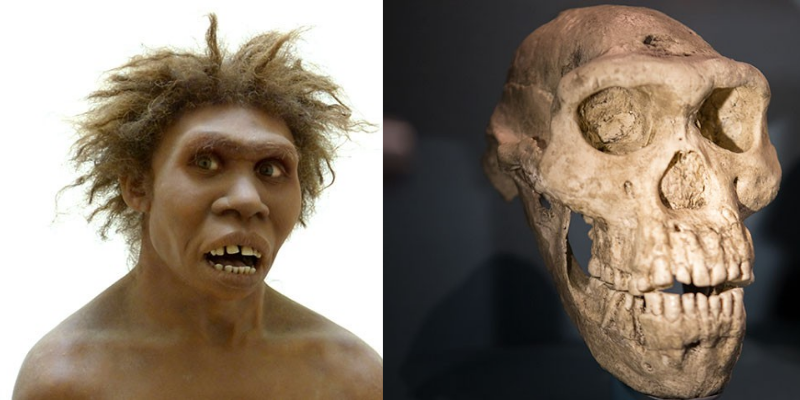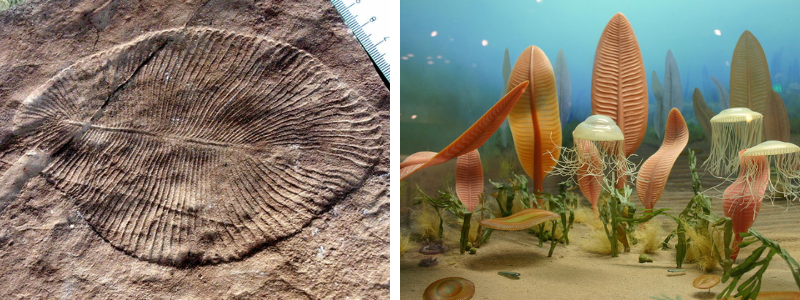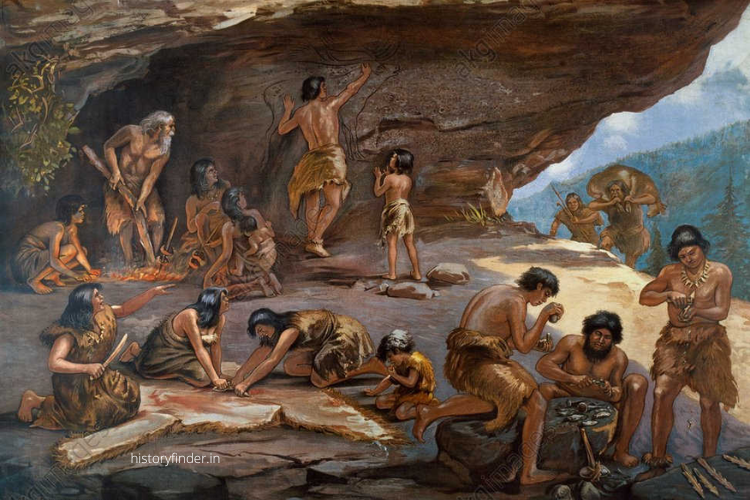Pre-historic India majorly refers to the stone age in the Indian sub-continents. There are lots of evidences that African Homo Erectus started expanding geographically around 2.5 million BCE. Archaeological studies say that some of them travelled and settled in north-western part of Indian subcontinents. Few archeological sites discovered in western Pakistan suggests so. Later they expanded further in various parts of India and settled.
There are so many archaeological sites have been discovered in India that proves stone age human colonization. Carbon dating tests indicate to different periods of stone ages. Few archaeologists also claim that few sites are from lower Paleolithic times. Unfortunately, none of the discoveries are older than 500,000 BCE.

The Stone age in India
Stone age in India has 3 major sub-divisions.
- Paleolithic or early stone age (c. 500,000 – 250,000 BCE). A period of development and adoption of stone tools. Stone age humans used chipped stone tools during this period.
- Mesolithic or Microlithic or mid stone age. Transitional phase between Paleolithic and Neolithic ages.
- Neolithic or late stone age (c. 10,800 – 3,300 BCE). A transitional phase between stone age and Chalcolithic or Copper age. Stone age humans had started polishing or sharpening their stone tools during Neolithic age. Not only that, use of colors in rock paintings is another development in this age.

Human presence in pre-historic India dates from the Paleolithic or early stone age. Arguably, it estimates somewhere about 2.2 to 2.5 million years ago. A tiny group of hominines started moving from Africa towards East Asia during c. 2,500,000 BCE. Homo Erectus skeletons were found in Indonesia dates to 1.6 million BCE and in East Asia of 1.2 million BCE. So, archaeologists believe Homo Erectus may have arrived in India at about 2 million BCE.
However, Homo Erectus fossil discovery at the Narmada valley remains the oldest in India that dates to 500,000 BCE.
Modern humans in pre-historic India
Homo Sapience or modern human arrival in Indian sub continents took place between 60,000 to 80,000 years ago. Y-chromosome and Mt-DNA evidences say modern humans of Indian subcontinents originate from Africa.
“Modern human beings—Homo sapiens—originated in Africa. Then, intermittently, sometime between 60,000 and 80,000 years ago, tiny groups of them began to enter the north-west of the Indian subcontinent. It seems likely that initially, they came by way of the coast. … it is virtually certain that there were Homo sapiens in the subcontinent 55,000 years ago, even though the earliest fossils that have been found of them date to only about 30,000 years before the present.”
-Tim Dyson, Historical demographer (source: Wikipedia)
Pre-historic sites in India
Pre-humans and modern humans both had expanded in various parts of Indian subcontinents. Several evidences are found from the rock arts discovered from different parts of India. The hills of Vindhya and Satpura has the highest number of such rock arts existing than of other parts of India. So, the Indian states of Madhya Pradesh and Uttar Pradesh are highly populated with stone age sites. However, several rock arts and other stone age tools have been discovered from other northern, western, southern, eastern and north eastern states as well.
Pre-historic stone age in Madhya Pradesh
Central India is highly rich in stone age rock arts. Bhimbetka & Adamgarh rock shelters are two of many other pre historic sites in Madhya Pradesh, India. Further, the region consists more than 750 rock shelters with pre-historic cave paintings. The artefacts and paintings points down to the Mesolithic and Neolithic stone ages in India.
Bhimbetka rock shelters
Rock shelters and caves of Bhimbetka refers to the Mesolithic or mid-stone age. It confirms the human presence in pre-historic Madhya Pradesh. However, the region comprises of 7 adjacent hills. It comes in the district of Raisen in present Indian state of Madhya Pradesh. Archaeological evidences confirm that some of those carvings are at least from 8,000 BCE.
UNESCO had declared this site as a World Heritage site in 2003. Visit UNESCO Bhimbetka page for more information.

The auditorium cave of Bhimbetka probably had a greater significance. Especially it’s construction and location suggests so. Bhimbetka paintings mostly depict pictures of hunting of pre-historic humans. The pictures also show stone age humans riding on horses while hunting. Further, use of various hunting tools are also noticeable from the rock paintings.
Dickinsonia fossils is another significant discovery of the region. This species class had disappeared during Ediacaran period in 635 million BCE. So, discovery of Dickinsonia in this region was really interesting for the archaeologists and other researchers.

Adamgarh Hills in Madhya Pradesh
Archaeologists discovered Adamgarh hills of Hoshangabad, Madhya Pradesh in 19th century. Initially 18 rock shelters or caves were there. But now, only 11 of them are clearly visible. Use of bows and arrows and animal riding are two noticeable points in these paintings.

The petroglyphs and pictographs refers to the lower Paleolithic stone age. However, some of the paintings also belong to the Mesolithic age.
Pre historic stone age in Uttar Pradesh
The range of Vindhya is extensively rich in Mesolithic sites. Eastern Vindhya or Kaimur range has 2 famous Microlith sites.
- Morhana Pahar
- Lekhahia
Morhana Pahar is another rock shelter that attributable to Mesolithic age. The archaeological site about 70 km south west to the Mirzapur town of Uttar Pradesh. A small scale excavation yielded antiquities like microlith tools and pot-shreds. Further, a rock painting depicts a chariot rider is just an amazing example of pre historic rock art.

Lekhahia is another microlithic site of Mirzapur district that dates of Microlithic age. The excavations yielded skeletons. However, the studies on those have not yet finished. But experts believe that some of it’s artefacts are attributable to pre-Microlithic times.
Here are some more Mesolithic and Neolithic stone age sites of Uttar Pradesh that are also important.
- Chopani Mando, Allahabad
- Sarai Nahar Rai, Allahabad
- Damdama
- Mahadaha
- Mahagara
Microlithic Maharashtra: Rock carvings of Konkan
Konkan rock carvings also confirm human colonization in Mesolithic age in the region. Archaeologists have discovered more than 1000 petroglyphs in the districts of Ratnagiri and Rajapur in Maharashtra. Studies have confirmed that these rock carvings belong to the Mesolithic age. Researchers also have found some stone tools that dates to 23,000 BCE.

The petroglyphs or rock arts were beautifully curved on the red laterite rocks. Konkan rock carvings mostly depict images of humans, animals. However, several petroglyphs also depicting some other figures as well.
Sudhir Risbood had discovered Ratnagiri and Rajapur petroglyphs in Konkan. But Risbood was completely unaware that he was actually discovering artworks of Mesolithic human. It clarified in 2016, when he showed photographs to Mr. Garge, the director of Directorate of Archaeology and Museums, Maharashtra. Mr. Garge soon appointed an official and carried out further proceedings. (Ref: The Hindu).
Mesolithic West Bengal: Birbhanpur village
Birbhanpur archaeological site is the one that dates to pre-historic West Bengal. Until the discovery of the village, pre historic cultures in this part of India were almost unknown. The village is located in the district of Burdwan on bank of river Damodar. AK Mukherjee, the local Zamindar, had discovered the site in early 1950s.
The sites are on the 2 different terraces of river Damodar. Therefore, those were named as Tn and Tn-1. A number of Microlith stone tools in form of cores, flakes, blades, lunates, points and scrapers were discovered from the excavation sites. Quartz, rock crystals and basalt were the raw materials of these stone tools. Another surprising part of this site is the discovery of fossil woods. It is really hard to believe that Mesolithic humans were using fossil woods.
Further, discovery of 10 holes of 1.2 meters depth indicates a probable existence of Mesolithic huts.
Other important stone age sites in India
Here are some important Mesolithic or Microlithic stone age sites from other states of India.
- Rajasthan:
- Bagor – Largest Mesolithic site in India, on the bank of Kothari river;
- Tilwara
- Gujarat:
- Langhnaj,
- Valasana,
- Ratanpura
- Loteshwar
- Bihar
- Paisra
- Paisra
Also find some Neolithic stone age sites from other states of India.
- Kashmir
- Burzahom
- Gufkaral
- Andhra Pradesh
- Utnur
- Piklihal
- Tamil Nadu
- Poyampali
- Karnataka
- Brahmagiri
- Sanganakallu
- Narsipur
- Kodekal
- Bihar
- Chechar




